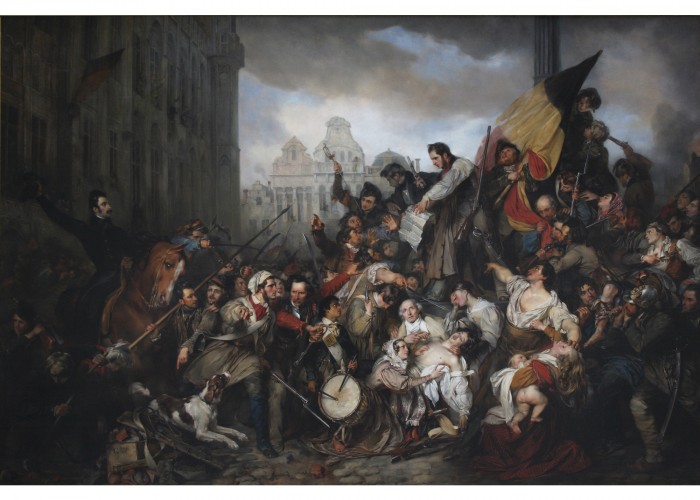Episodes from September Days 1830 on the Place de l’Hôtel de Ville in Brussels
This painting by Gustaf Wappers depicts the Belgian Revolution of 1830, which resulted in the independence of Belgium from the Dutch-ruled United Kingdom of the Netherlands.
Following the final defeat of Napoleon in 1815, at the Battle of Waterloo, the countries of Europe were determined to ensure that no single country would be able to rule over Europe again, and that there would be protection for all against revolution. The congress system or ‘Holy Alliance’ was set up. It changed the boundaries of some countries, including the United Kingdom of the Netherlands, which now included Belgium. Its members also agreed that European States would come to each other’s help in times of crisis.
By 1830, people in the southern region of the Netherlands had become greatly opposed to rule by its King, William I, who they saw as a dictator. The calls for independence grew louder until they broke into full scale riots in Brussels. William used his army to gain temporary calm but refrained from further military intervention, appealing to the European powers for support.
The resulting London Conference recognised Belgian independence and installed King Leopold in place of William. King William made an attempt to reconquer Belgium but failed due to intervention by the French. In 1839 the Dutch finally agreed to Belgian independence, which was ratified in the Treaty of London.
Gustaf Wappers (1803-1874) was a Belgian painter. He was the first Belgian painter to adopt the new ‘Romantic Movement’. This work is considered his masterpiece. It shows an imagined scene at the height of the anti-Dutch riots in the centre of Brussels. The painting received great acclaim and Wappers was promoted to Director of the Antwerp Academy.
Did you know..?
One of the triggers for the riots was the performance of a previously-banned opera in Brussels on 25 August 1830, La Muette de Portici (the earliest French ‘grand opera’ written by Daniel Auber), which was about an Italian rebellion against the Spanish in the 1600s.
-
Did you know..?
One of the triggers for the riots was the performance of a previously-banned opera in Brussels on 25 August 1830, La Muette de Portici (the earliest French ‘grand opera’ written by Daniel Auber), which was about an Italian rebellion against the Spanish in the 1600s.
-
Education overview
You can access a range of teachers resources related to this object and more on our education page.
Please also see our glossary of terms for more detailed explanations of the terms used.
-
Curatorial info
- Originating Museum: Royal Museum of the Fine Arts, Brussels
- Production Date: 1835
- Creator: Gustaf Wappers
-
Use this image
You can download and use the high resolution image for use in a non-profit environment such as a school or college, but please take note of the license type and rights holder information below
- Rights Holder: Copyright Royal Museum of Fine Arts, Brussels.
- License Type: All Rights Reserved
Find it here
This object is in the collection of Royal Museums of Fine Arts of Belgium






